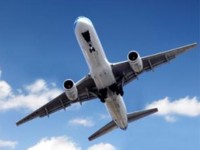On a Wing and a Prayer - Airlines Seek Tougher Emission Rules
 Montreal - The International Air Transport Association (IATA), the industry association for the civil aviation sector, today urged the International Civil Aviation Organization (ICAO) at a High Level Meeting on International Aviation and Climate Change (HLM-ENV ) to move forward faster to implement an even more ambitious emissions reduction agenda for the sector.
Montreal - The International Air Transport Association (IATA), the industry association for the civil aviation sector, today urged the International Civil Aviation Organization (ICAO) at a High Level Meeting on International Aviation and Climate Change (HLM-ENV ) to move forward faster to implement an even more ambitious emissions reduction agenda for the sector. “We took a step in the right direction, toward a global sectoral approach, but there is still a lot of ground to cover. As a united industry, we remain committed to the ambitious environmental targets that we brought to this meeting. Governments took note of our targets and recognized the need to work with industry to secure a sustainable future for aviation. This is significant progress,” said Giovanni Bisignani, IATA’s Director General and CEO.
In a joint working paper by IATA with Airports Council International, Civil Air Navigation Services Organisation and International Coordinating Council of Aerospace Industries Associations, a united industry committed to three sequential targets:
- Improving fuel efficiency by an average of 1.5% annually to 2020
- Stabilizing emissions from 2020 with carbon-neutral growth
- A 50% net reduction in carbon emissions by 2050 compared to 2005
IATA (International Air Transport Association) represents some 230 airlines comprising 93% of scheduled international air traffic.
The ICAO Declaration confirmed the desire of governments to deal with aviation and climate change through ICAO and in coordination with the United Nations Framework Convention on Climate Change (UNFCCC). The Declaration also contained the following commitments for:
- States to work together to achieve a global annual average fuel efficiency improvement of 2% to 2020, followed by an aspirational goal of a further average annual 2% improvement from 2021 to 2050
- ICAO and its contracting States to evaluate the possibility of more ambitious goals by the next ICAO Assembly (2010), taking into consideration industry’s collective commitments and the special needs of developing nations
- ICAO to establish the process to develop a framework for economic measures
- ICAO and its contracting States to encourage the development and use of sustainable biofuels
Airlines have set even more ambitious targets than governments for the longer term. “Industry is targeting net carbon emission reductions, while government discussions are focused on efficiency improvements.
It is ironic that industry is setting tougher targets for itself than its regulators are prepared to require. But, our common goal is to effectively address climate change. That means reducing emissions. The challenge is to work together to close this gap by the next ICAO Assembly in September 2010.” Giovanni Bisignani IATA’s Director General and CEO.
In the medium term, to 2020, governments have set a more ambitious average annual fuel efficiency improvement target (2% per year) than the industry’s 1.5%.
“Setting such a target comes with responsibility. We can fly the plane efficiently, but governments must deliver improvements in air traffic management-NextGen in the US for example.
Governments must back their target with infrastructure investments to make it achievable. Governments must also accelerate the development of the legal and fiscal frameworks to support the use of sustainable biofuels,” said Bisignani.
“Most importantly, today’s Declaration sets the stage for future developments towards a global sectoral approach. Sustainable biofuels and a framework for a global approach to economic measures are key items that the Declaration has committed to address,” said Bisignani.
“The aviation sector will approach Copenhagen with a strong forward-looking vision for its future as a role model for other industries to follow. I congratulate ICAO Council President Roberto Kobeh González and ICAO Secretary General Raymond Benjamin for their leadership in achieving this significant Declaration. The outcome of the HLM-ENV gives us much needed scope to further develop our strong industry cooperation with governments through the UN framework,” said Bisignani.
Click here for the ICAO Declaration (pdf) and here for the Industry submission to ICAO HLM-ENV (pdf)
For More Information: IATAYou can return to the main Market News page, or press the Back button on your browser.

